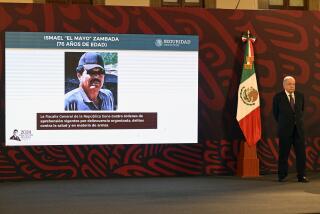A poignant tale from ex-Marine held in Mexico, but not the whole story
Andrew Tahmooressi, the former Marine sergeant who spent seven months imprisoned in Mexico, will spend a quiet Veterans Day at home with his family in Florida. He was released by a Mexican federal judge on Oct. 31, after a finding by both defense and prosecution psychiatrists that he suffered from Post Traumatic Stress Disorder, and that it should be treated in the U.S.
It’s not clear if this was the result of a change in strategy on the part of Tahmooressi’s Mexican attorney, Fernando Benitez, or political pressure applied by American elected officials, who actively pressed for Tahmooressi’s release, even holding a congressional hearing where talk show host Montel Williams, a former Marine, testified about the dangers of PTSD. Former New Mexico Gov. Bill Richardson, an experienced negotiator, played a role as well, helping coordinate Tahmooressi’s release, and arranging his transportation home to Florida by private jet.
However it happened, this was an excellent outcome for Tahmooressi, who did two tours of duty in Afghanistan and earned a battlefield promotion during his deployment before retiring in 2012.
Tahmooressi had maintained all along that he had taken a wrong turn, and accidentally crossed into Mexico with many of his possessions in his truck, including three loaded guns and 400 rounds of ammunition, a flagrant violation of Mexico’s strict gun laws. I’ve written about the case here, here and here. I have never found any comfort in the idea that an American combat veteran suffering from what his mother described as “hunter-prey” syndrome, in which he imagines that he is the prey, was driving around, feeling paranoid and vulnerable, with three loaded weapons in easy reach. That always struck me as a recipe for disaster.
On Thursday, Tahmooressi sat down for an interview with Greta Van Susteren, who had championed his case on the Fox News Channel. It was not the first time he’d spoken publicly about his case. During his incarceration, Tahmooressi had granted interviews to Van Susteren as well as to U-T San Diego’s Sandra Dibble.
But this was his first on-camera interview after his release, and it was painful to watch.
Tahmooressi, 25, may be a military hero, but he is also an emotionally fragile young man. He was clearly uncomfortable in the spotlight, spoke slowly and sometimes seemed to have trouble finding the right word.
“At first, he didn’t think he was up to the interview, but after some thought, he changed his mind,” said Tahmooressi spokesman Jonathan Franks. “He is scrupulously honest, and he sat there and told his truth. I think there was some catharsis to telling it.”
Maybe. But it’s hard to imagine someone suffering from PTSD gaining much from exposing his most private and embarrassing experiences to a national audience.
When he made that wrong turn on March 31, and found himself in Mexico, he told Van Susteren, he was already in a bad emotional place. He said he’d been watching “conspiracy films” that made him paranoid.
“I felt like a target,” he told her. “It made me change the way I thought about things and things that I believed.” He also told her that he had once pulled a gun on someone he thought was threatening his family, thought it was unclear when that incident occurred.
Being thrown into La Mesa, a tough Mexican prison, he said, was disorienting. He spoke no Spanish and thought other prisoners were plotting against him. He said he was “bugging a whole lot” and felt “sketched out.” And there was something else: a girl he was dating was about to leave him. “So I was heartbroken and feeling helpless.”
He tried to escape by jumping over four barbed wire fences before being caught at the prison’s front gate. When he was caught, he said, guards hit him with sticks and “open palms, nothing full-blown” and kicked him while he was on the ground. “I was actually joyful to take that beating,” he said. “I knew the beating was coming. They were telling me stories about the guards, about how if someone acts up or does something wrong they get beat. So I already knew it was going to happen to me.”
After that, he said, guards chained him to a bunk bed where he was forced to stand naked overnight. They put him in a small, dark cell, he said, made him lie on a bed, and handcuffed one arm and one leg to the bed. He was unable to properly relieve himself, and felt the guards were laughing at him. His panic, as he described it, was palpable.
The time frame is unclear, but just after that, while he was alone in a cell, he tried to kill himself with a neon light tube that he yanked from the ceiling, broke against the toilet and gouged into his neck.
Mexican prison guards heard the noise, Tahmooressi said, and rushed to his cell. He did not acknowledge that they probably saved his life by rushing him to the infirmary, where he was treated for his injuries and blood loss.
Saying such a thing would not fit neatly with popular narrative for this story: that Mexico is a bad actor, that Tahmooressi was railroaded, that he was mistreated from start to finish, and preposterously, that President Obama “left a man behind on the battlefield” for failing to personally intervene in the case.
Van Susteren’s lack of basic journalistic balance compounded the problem. Viewers never heard Mexico’s side of the story. Why was Tahmooressi put in restraints? Was it to prevent him from making another dangerous escape attempt, or because prison officials were worried he try to kill himself again? Why not confront Mexican officials about Tahmooressi’s abuse allegations?
Tahmooressi, who was moved to a private cell in the more modern El Hongo prison after he attempted suicide, did not talk about the many visits he received from his pastor, his attorneys, State Department representatives, his mother and a variety of American politicians, including U.S. Reps. Matt Salmon and Ed Royce. Nor did he mention that he was allowed to speak to his mother twice a day, though he did say he was upset that she was forced to undergo a strip search when she visited him once in prison.
Van Susteren did ask him about why he was driving around with three loaded weapons – a rifle, a handgun and a shotgun--in the first place.
“U.S. Marines have guns on them all the time,” he explained. “Our gun is our safety…. You have all your boys there in the Marine Corps with you, and you’re all protecting each other, and then you get out here and you’re all by yourself. You know, you feel very vulnerable.”
On Monday, the Tijuana newsweekly Zeta reported that the confidential release order for Tahmooressi, signed by Mexican federal judge Octavio Luna Escobedo, noted that Tahmooressi has been addicted to marijuana, which he began smoking at age 15, and that he was diagnosed with PTSD at age 18, when he joined the armed forces. (In her story, Zeta reporter Ines Garcia Ramos noted that after a court hearing in August, Tahmooressi’s attorney said that he would not use PTSD as a defense because “it is not a condition which precludes you from understanding the difference between good and evil.”)
“He did not have PTSD prior to entering the service,” said family spokesman Franks. “I don’t know whether the judge made a mistake. That was not the conclusion of the State Department doctor or the VA doctors.”
I believed from the start of this case that the judge would find a way to get Tahmooressi home sooner or later, and that insulting and threatening Mexico, or comparing Tahmooressi’s situation to that of Sgt. Bowe Bergdahl, who was swapped for five Guantanamo prisoners, was specious, not to mention counterproductive.
Tahmooressi made a terrible mistake and paid a very dear price. Mexico’s humanitarian gesture was the right thing.
Now that he’s home, let’s hope that he--and thousands of other vets suffering from PTSD-- receive the care and support that they have earned.
[For the Record, 1:45 p.m. PST Nov. 10: An earlier version of this column reversed the prisons where Tahmooressi was held.]
Please follow me on Twitter: @robinabcarian
More to Read
Sign up for Essential California
The most important California stories and recommendations in your inbox every morning.
You may occasionally receive promotional content from the Los Angeles Times.











